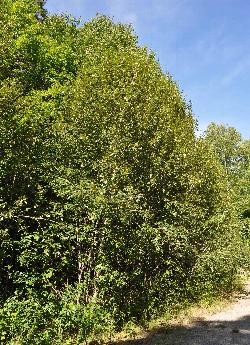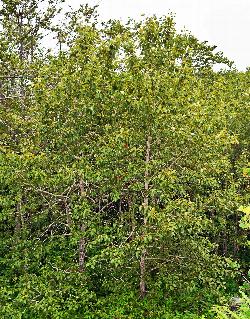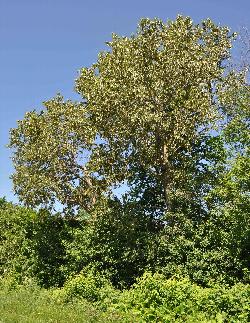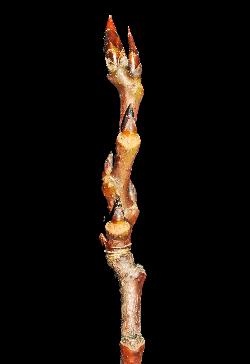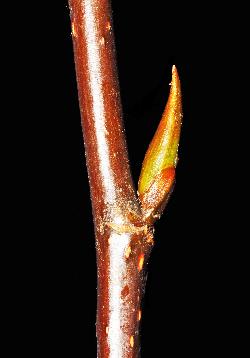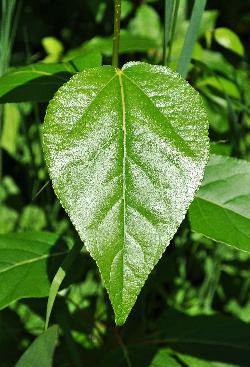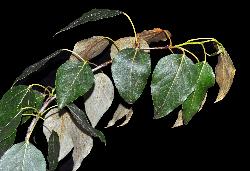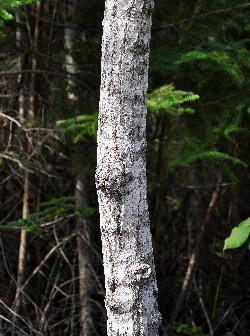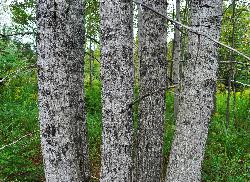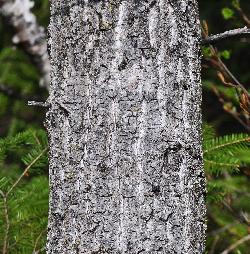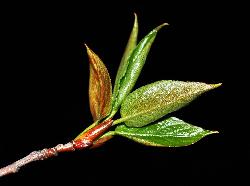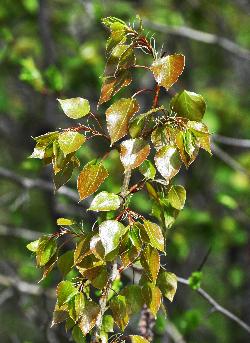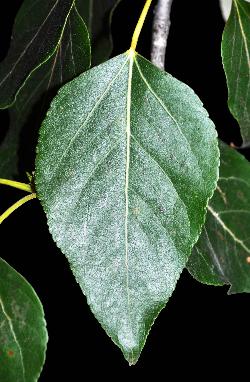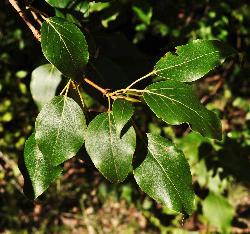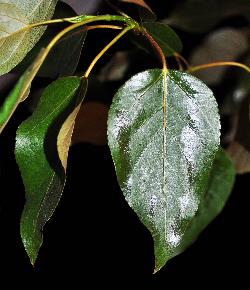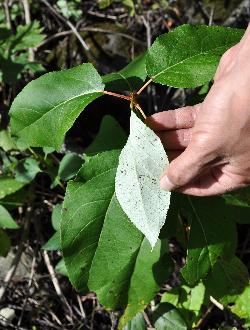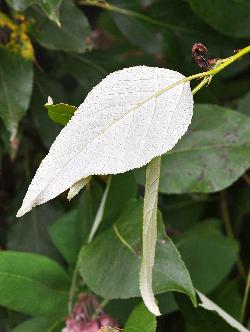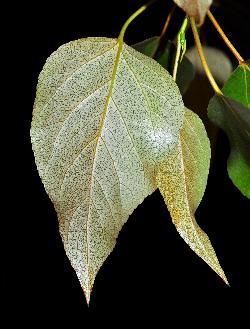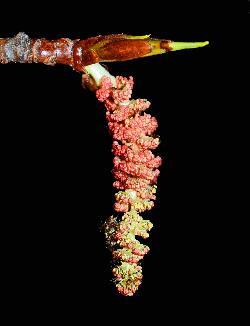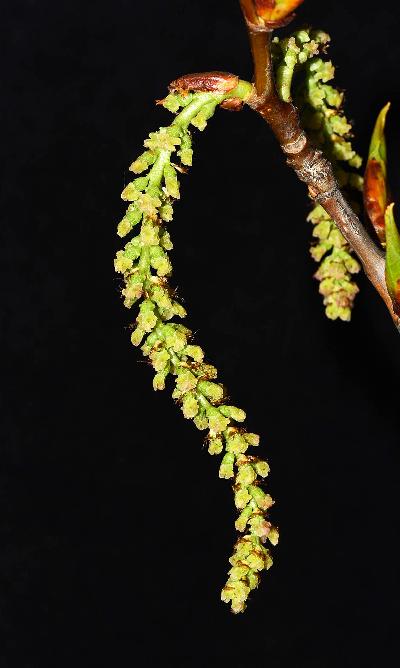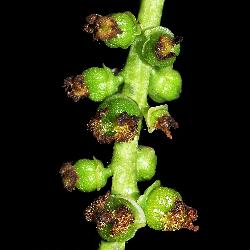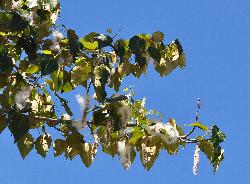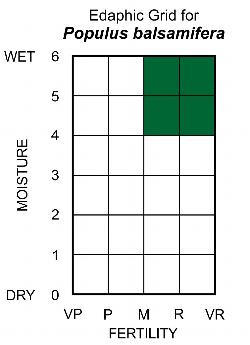Fr: peuplier baumier, peuplier tacamahacca
IA: mashi-mitush
IU: uppialuk
Salicaceae - Willow Family
Note: Numbers provided in square brackets in the text refer to the image presented above; image numbers are displayed to the lower left of each image.
General: A fast-growing, medium-sized to tall deciduous tree, reaching 30 m in height, with a d.b.h. of 2.1 m [1–3]. Balsam poplar is a relatively short-lived tree, 100–150 years old, although some trees have been known to reach 200 years of age (Zasada and Phipps 1990). A pioneer species, balsam poplar quickly colonizes floodplains and disturbed shoreline sites, usually forming mainly even-aged stands (Zasada and Phipps 1990). Balsam poplar can reproduce readily by vegetative means from stumps, root suckers, or broken branches (Zasada and Phipps 1990), and can adapt to occasional sediment deposition by developing roots from newly buried stems. Balsam poplar is not used commercially in Newfoundland and Labrador, but provides browse for moose, while beavers will harvest shoreline trees for food, building dams, and lodges (Zasada and Phipps 1990).
Key Features:
- Buds are sharply pointed and very resinous; the first bud scale is situated directly above the leaf scar [4–6].
- Leaves are ovate and taper gradually to an acuminate apex, bases range from broadly cuneate or rounded to slightly cordate [7–8].
- Lower leaf surfaces are white and often resin-tinged [9].
- Flowers are unisexual and arranged in pendant catkins; the male and female catkins are borne on separate trees. Female flowers have a globose superior ovary, topped by a broad, lobed stigma and subtended by a shallow, cup-shaped disc [10].
Stems/twigs: Twigs are green when young, then become reddish-brown to greyish-brown, glabrous, and often shiny. Buds are alternate, lustrous, and scaly, with 3–5 greenish to reddish-brown imbricate bud scales [4–6]; buds are very resinous, often bearing a resin drop at the edge of the scales, and have an aromatic balsam fragrance. Terminal buds are lanceolate, sharply pointed (acuminate), and 12–16 mm long. As in all poplars, the smaller lateral leaf buds have the first bud scale positioned directly above the leaf scar, which is elliptic to slightly 3-lobed with 3 bundle trace scars [4–5]. Flower buds, 15–19 mm long, are larger than vegetative buds and clustered near the branch tips. Trunks of younger trees have smooth greenish-brown bark; mature trees have grey furrowed bark with scaly ridges [11–13].
Leaves: Alternate, simple, pinnately-veined, and petiolate. Petioles are 1.5–5 cm long, yellowish-green to reddish, and terete to slightly flattened near the blade, but in the same plane as the leaf. Immature leaves [14–15] are lanceolate to ovate, glossy and glabrate (slightly pubescent, but becoming glabrous). Mature leaf blades are lanceolate, ovate, to somewhat cordate, generally glabrous above, and measure 5–12 cm long by 3–5.5 cm wide [16–17]. Petioles and veins along the lower surface may be slightly pubescent. Leaf bases are broadly cuneate, rounded, or slightly cordate; apices taper gradually to a point (acute to acuminate); margins are finely crenate, with 20–44 low rounded teeth on each side [17]. Leaf blades are dark green, either dull or shiny with resin, and glabrous above [18–19]. The lower leaf surface is glabrous and distinctly white-glaucous [20–21], often stained reddish-orange by resin [9, 22]. Leaves turn yellow in autumn.
Flowers: Unisexual; plants dioecious, with male and female catkins on different trees. The somewhat loosely-flowered pendant catkins have about 50–70 flowers and emerge before the leaves; nectaries are absent. Both male and female catkins are long and slender when fully expanded; each flower is subtended by a deeply dissected brown bract that falls off soon after the catkins elongate. Male catkins are 5–10 cm long and their flowers each have 20–30 stamens attached to a flat disc [23–25]; the immature reddish anthers soon turn yellow as the catkin elongates and pollen is shed. Female catkins are 10–15 cm long, each flower is borne on a short pedicel, 0.5–2 mm long [26]; perianth parts are modified into a shallow slightly-lobed cup-shaped disc, 2–3 mm across, which subtends an ovoid to spherical superior ovary with 2 carpels and a broad, 2–4-lobed, yellow stigma [27] that turns brown as the young capsule develops [28]. Poplar flowers are wind-pollinated (anemophily).
Fruit: Fruiting catkins are 7.5–18 cm long. Capsules are numerous, ovoid, green, glabrous, and 5–8 mm long, borne on short pedicels, up to 3.5 mm long. Poplar capsules split into 2 halves (valves) and have 15–22 seeds per valve; each seed is topped by a tuft of silky white hairs. When capsules dehisce, clouds of tiny wind-borne seeds form fluffy masses in the crown [29] before being dispersed long distances by wind currents. Where trees grow along shorelines or floodplains, water currents will further disperse seeds that land in rivers.
Ecology and Habitat: Balsam poplar is generally uncommon in the province, but occurs in western and northern Newfoundland, and in Labrador as far north as treeline. It grows best on alluvial floodplains, usually in association with white spruce, but has been observed in dry lichen woodlands on sand dunes in Labrador (Wilton 1965).
Edaphic Grid: See image [30]: the Edaphic Grid for Populus balsamifera.
Forest Types: Balsam poplar is a component of a single described forest type in Newfoundland and Labrador (Damman 1967):
- Alnetum solidagetosum (Solidago-Alder Swamp Subassociation)
Damman (1963) also described an occurrence of balsam poplar on the Northern Peninsula, an Arctostaphylos–Shepherdia-Black Spruce Fen community, growing on a gleyed podzol soil type over limestone.
Succession: Balsam poplar is a rapidly-growing, early successional species that is very shade-intolerant. It is uncommon in Newfoundland and Labrador, and rarely forms pure stands; instead, is usually occurs in open stands with balsam fir and white spruce on floodplains, but is eventually replaced by the conifers after 80–100 years (Zasada and Phipps 1990). Balsam poplar occasionally occurs on sandy terraces in the early stages of dune stabilization.
Distribution: The range of balsam poplar stretches from Ramah (58° 54' N) in northern Labrador (Scoggan 1978), south through central and southern Labrador, west along the northern tree limit, across Canada to the Yukon, and into Alaska. Along its southern border, balsam poplar extends from the Northern Peninsula and western Newfoundland, southwest through the Maritimes, west through Québec, Ontario, and the Prairie Provinces, then northwest to northern British Columbia. In the United States, its main range extends west from Maine to Minnesota, barely crossing the border of the Dakotas, and with smaller isolated populations found in several other states (Zasada and Phipps 1990).
Similar Species: Trembling aspen (Populus tremuloides Michx.) is the only other native poplar in Newfoundland and Labrador. It can be recognized by its widely ovate leaves, which have 3 main veins, finely crenate-serrate margins, a paler but not glaucous lower surface, and rounded to truncate (flat) bases. Trembling aspen has obviously flattened petioles, which allow the leaves to flutter in the wind, and lacks the resin-staining common in balsam poplar. Balsam poplar can hybridize with other poplar species, but no hybrids have been documented between balsam poplar and trembling aspen (Eckenwalder 1997).


